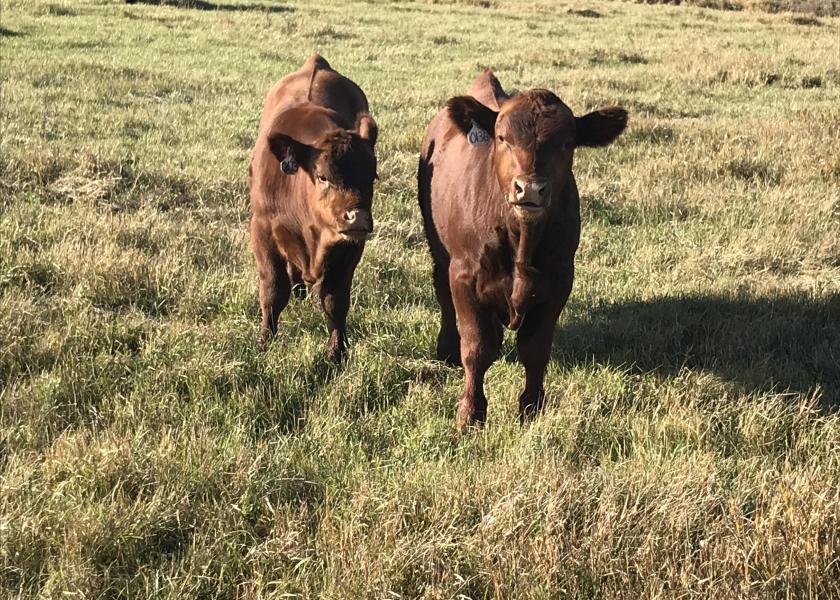Early Weaning a Drought Management Strategy

Rainfall is one of the most important factors that influence management decisions on the ranch, according to North Dakota State University Extension livestock specialists.
This year is no different because most of North Dakota is experiencing severe dry weather. Drought conditions drive management of native pasture, crop residue and cover crop acres. Typically, even with good moisture during mid to late summer, the nutritional value of native pasture is in decline. This decline is accelerated under dry conditions.
“Early weaning is one of the management decisions that can help reduce pressure on native pastures and extend forage supplies for adult beef cows,” says Janna Block, Extension livestock systems specialist at NDSU’s Hettinger Research Extension Center. “Early weaning simply means weaning calves at an earlier age to reduce forage usage while not compromising calf health and performance.”
Dairy calves often are weaned as early as 8 weeks of age. This is achieved through proper nutrition with feeds that promote rumen development. This enhances the development of the rumen so the calf can survive very well without the nursing milk diet. From the standpoint of feed efficiency, feeding calves directly is more efficient than feeding cows to sustain milk production.
Beef calves can be early weaned successfully from 60 to 150 days of age.
Most producers notice that nursing calves also will consume forage, whether through grazing or being fed harvested forages. Research shows that early weaned cows will consume as much as 35% to 45% less forage than normally weaned cow-calf pairs.
Early weaning typically results in improved body condition of dams due to decreased nutrient requirements. A cow weighing 1,400 pounds would require about 16 pounds of energy (total digestible nutrients, or TDN) and 2.5 pounds of crude protein (CP) on a daily basis in late lactation. This same cow’s requirements would decrease to 12 pounds of TDN and 1.7 pounds of protein after weaning. In addition, water requirements would decrease by about 55% to 60%.
“It is important to distinguish between early weaning and creep feeding based on the goals of each strategy,” says Zac Carlson, Extension beef cattle specialist.
“Creep feeding is the act of providing supplemental feed to nursing calves,” he notes. “The primary goal of creep feeding is to increase weaning weight of calves. While creep feeding may result in some substitution of forage for creep feed, it does not reduce nursing pressure on cows. Therefore, this practice will not provide the same forage savings and increases in cow condition that can be gained from early weaning.”
Early weaning should not compromise calf health and it should enhance performance. The key to successful early weaning is to treat groups of calves as unique. Weaning by pasture group is preferred, with no commingling of other groups after weaning for at least 45 days. Even though all calves have been born and raised on the same ranch, the pasture group is the stable unit as it relates to shared organisms and social pecking order.
“If weaning includes commingling all pasture groups at the same time into a common weaning pen or pasture, be prepared to begin treating calves for respiratory disease 10 to 14 days postweaning,” says Gerald Stokka, Extension veterinarian and livestock stewardship specialist. “Alternatively, make provisions to bring all cows and calves together such that the social order and shared organisms of calves can be re-established prior to the stress of weaning. The more space that is provided (i.e., pasture weaning), the less the pressure on re-establishing social structure and the less transmission of organisms during this stressful time.”
Other potential risk factors may influence health at this time as well. Lack of passive immunity, temperature fluctuations, heat stress, nutritional stress prior to weaning, dusty pens and handling stress may impact the healthy transition to weaning negatively. The lack of adequate passive transfer of immunity from the birth mother to the calf increases the risk of postweaning death.
Temperature fluctuations may compromise the normal respiratory defense mechanisms of calves, as do heat stress and dusty pen conditions. Dry conditions may result in nutritional stress prior to weaning, so make sure that appropriate protein, energy, and mineral supplements are provided prior to and after weaning.
If calves need processing, such as for vaccinations or deworming, do it early in the morning or delay processing until temperatures moderate. Processing can be done at the time of weaning; however, only products that benefit the animal at weaning and do not compromise the immune response should be used. Processing done at least three weeks prior to early weaning is preferred and provides the opportunity to administer booster doses postweaning if necessary.
Facilities may need some remodeling if weaning calves that are significantly smaller than normal. Calves become adept at finding ways to return to their dams or at least escaping the weaning facility. Because smaller and younger calves may have difficulty competing for feed and water, sorting them into several pen groups based on size and age may be necessary.
“Early weaning is a management tool that can significantly reduce forage and water demand,” Block says. “In addition, with proper preparation, calf health and performance are not compromised.”







